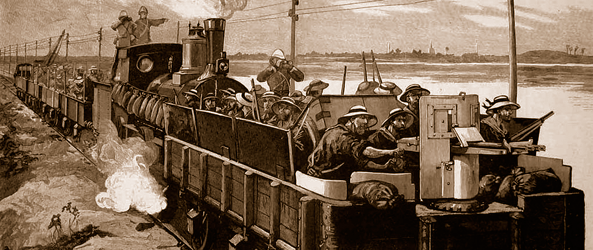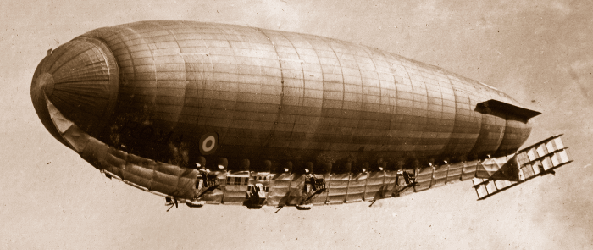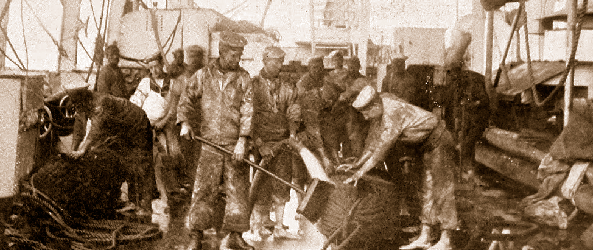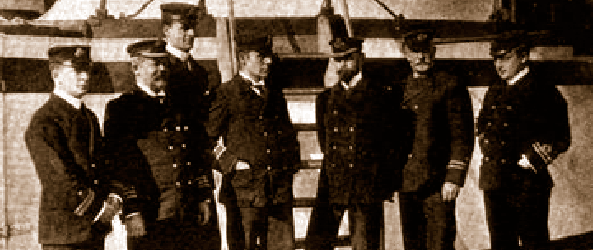Swift Class Aerial Monitor (200 tons)
 |
| click image to download a PDF version. |
The Swift gunboats are an experimental attempt to increase safety for British shipping in the Oenotrian border regions, especially near the foothills of the Shistomik Mountain range. While it bears a resemblance to the slightly smaller Aphid class, it learns from the lessons taught by previous Martian experience. It has the same armor, allowing it to ignore the effects of the smaller Martian cloudship guns, but in addition, it also armors all its guns, including its complement of four Nordenfelts. This was done to protect the relatively small crew complement from damage that the ship would otherwise ignore. Aphids have a poor reputation for crew safety, sometimes limping home in good condition, but with decimated crews, the open gun mounts making them easy prey to hostile fire. The Swift also uses the new forced draught steam engines, which allow it sufficient speed to evade almost all ramming attempts, as well as being able to pursue and overtake all known vessels in the colonies. Three Hale rocket batteries provide short range firepower, and the 3" HRC's, while small, have a high rate of fire, and are sufficient to wreak havoc on the poorly protected Martian vessels which the Swift was designed to combat.
Critics of the Swift complain that it does not have enough long range weaponry, and its altitude limitations render it vulnerable to attacks by the Martian Fire so common on larger vessels. Also, since it has only one Marine observer, it is especially vulnerable to being boarded. These criticisms are largely ignored at this point, since it is not designed to assault the crag keeps of the High Martians, and its batteries of Nordenfelts should be sufficient to discourage all but the most suicidal of boarding parties. Also, if this should become a problem, the Hale batteries can be easily dismounted, which would provide sufficient room for a temporary complement of six more Marines, quite enough for a vessel of this size.
Impenetrable Class Aerial Monitor (1000 tons)
 |
| click image to download a PDF version. |
The Impenetrable is largest vessel currently under construction at the Syrtis Major shipyards. While not the largest vessel in Martian use, she will be the most heavily armored. In fact, the armor plating of the hull is too complex for the limited facilities on Mars, and the vessel is being shipped piece by piece from Birmingham, and assembled on site. As expected, this is a very costly undertaking, and the Foreign Office has drawn considerable fire from the liberal press for this "escalation of warlike tendencies" and "waste of money". The official rationale for the Impenetrable is that a vessel impervious to Martian weapons will prove the futility of native resistance, and once and for all stop the insurrections and piracy on British shipping that are now a major problem. Indeed, only the heaviest of Martian weapons can penetrate the hide of this vessel, while her complement of weapons is sufficient to destroy many Martian vessels in a single broadside. While not the awesome guns of water-bound ironclads, they are able to penetrate the armor of any foreign naval vessel currently in use. It is exactly these qualities which makes it such a destabilizing influence. Many fear that a vessel impenetrable by Martian weapons will drive the rebellious factions into the arms of some other nation which can supply them with heavier weapons, leading eventually to all-out warfare.
Critics of the design note its lack of heavy armament, altitude restrictions, and small complement of marines, all necessary sacrifices to achieve the extraordinary level of armor on the vessel. To its credit, it has a normal 20 day steaming range, a highly respectable top speed, and sufficient staying power to survive battles against more heavily armed opponents.
On the current construction schedule, observers note that it will be approximately 18 months before the Impenetrable can be launched, not counting delays due to public sentiment, economics, or potential problems with demagnetizing such a large mass of metal to avoid premature liftwood deterioration.
Swiftwing Courier (83 tons) - Screw galley
 |
| click image to download a PDF version. |
Oenotrian factions battling the British are hampered not only by the tenacity of the Colonial army, but also by the age and tradition of their race. Unable or unwilling to change to more modern technologies, they require vastly superior numbers in any sort of military engagement, and still take frightful losses on occasion. However, not all Martians are hidebound by the ancient traditions, and some very few are learning lessons from colonial forces. Some of the first signs of this are shown in the Swiftwing, a ship built solely for high speed transport of cargo or important persons. Some seventy-five percent of the vessel is taken up with slave turncranks, giving the Swiftwing an extraordinary burst speed of 25 knots. This is also partially due to improvements in their airscrews, the design appearing a direct copy of the latest British vessels. The sole armament of the Swiftwing is a stern mounted sweeper, although up to 5 marines or an important personage and their bodyguards can also be carried.
Swiftwings are currently being used as scouts and transports, and sightings have preceded attacks on at least two occasions. While not quite as fast as some British vessels, superior knowledge of terrain and local sympathy have allowed almost all Swiftwings to escape capture by colonial forces. The only one that has been captured so far was also equipped with facilities for mounting a mast and sails, a feature which would greatly extend its cruising range and long-term speed, but expert analysis indicates that the extra weight of rigging would mandate a reduction of the extra crew, removal of the stern gun, or a sacrifice of maximum altitude.
Cleansing Wind (400 tons) - Screw galley
 |
| click image to download a PDF version. |
The Cleansing Wind is another disturbing development of cloudship design, showing that more and more, new ideas are gaining acceptance in the traditional quarters of the Martian military. Others claim it is a sign of covert foreign support, but cooler heads say it seems unlikely the Oenotrian forces are desperate enough to join one set of "Red Devils" to repel another. The expert opinion at this time is that the design is an independent pirate vessel, but there is no proof one way or the other. Both the name and the style of this new ship have caused concern in diplomatic and military circles, although as yet, only one example has been seen.
The Cleansing Wind has almost abandoned the traditional screw galley design and armament in favor of a more modern outlook, and at range can be mistaken for a British vessel. Whether this is by design, or just simple plagiarism has yet to be determined. It does not mount any of the heavy rod or lob guns usually found on the larger screw galleys, and is not equipped with that most traditional of Martian weapons, the ram. Instead, it mounts three heavy guns, two lights and four sweepers, along with a single rack of the deadly Martian Fire. All these weapons are effective against the lighter of Her Majesty's ships, and especially so against civilian shipping. For a Martian vessel, it is singularly well armed, in quantity if not quality, and with a top speed measured at 20 knots, able to maintain distance from most heavy vessels, and close with the relatively slow merchants it may encounter. The size of the vessel is also disturbing. It is not a large vessel in Martian terms, and is seems very likely it was designed to accompany larger vessels or operate with large groups of similar sized ships.
The only sighting of this vessel to date was from H.M.S. Bellerophon, an Aphid class gunboat operating out of Srytis Major. The Cleansing Wind was encountered on a routine patrol, and refused to heave to. After an inconclusive engagement, both vessels turned and delivered point-blank broadsides. Bellerophon, crippled by a magazine explosion, made it home only by jettisoning her coal reserves, while the Cleansing Wind was unable to pursue due to heavy screw damage. However, it was seen to leave the area under its own power before Bellerophon disappeared from sight, and is presumed to be fully repaired by this time.
Scenario - Surprise Encounter
HMS Warrior, a Swift class monitor, was engaged in towing home HMS Firefly, an Aphid class gunboat which had been damaged in a scuffle in the Shistomik lowlands, when they encountered two Oenotrian vessels searching for prey. In hostile territory, with one crippled vessel, Her Majesty's ships decide to flee to friendly territory rather than get into a protracted engagement.
The Martian vessels, surprised by the appearance of the British vessels, nonetheless seized the opportunity, and attempted to cripple or destroy the Red Devils without taking any losses themselves.
Setup - Martians get the Cleansing Wind and a Small Bird screw galley, which they set up anywhere in the three hexes between the crags on the mountain map. One vessel is allowed per hex, and both must be facing along that row of hexes. Cleansing Wind has Canal Martian marines, armed with muskets. Initial altitude is High.
British start with the Warrior, and an Aphid class gunboat. Warrior starts in the hex with "1889" in it, facing NW, and Firefly is in the hex immediately behind it. Initial altitude is Medium. Firefly may start the game towed, in which case the vessels move at speed 4, or may be cut loose, in which case they move separately. The tow line may be cut at the start of any British movement, but the Firefly does not get to move at all on that turn.
Special Rules - Firefly has been damaged. The 1 pound HRC and Nordenfelt on the starboard side have been destroyed, and their crews killed. Mark them off. In addition, she is missing one deck crew, one engine crew, and three hull boxes. Due to engine damage, Firefly can only move intermittently. Each turn, right before British movement, roll 1d6. This is the number of MP the Firefly has for that turn. Initially, Warrior may assign some of her crew complement to Firefly, in which case these crew are subtracted from those on the Warrior. If either ship is forced to lose altitude due to damage, the stress will immediately sever the tow line, leaving Firefly immobilized for a turn.
Victory Conditions - Martians get 2 VP for each British ship destroyed or grounded, and 1 VP for each ship de-crewed or de-weaponed. British get 2 VP for each Martian ship destroyed or grounded, and 1 VP for each ship de-crewed or de-weaponed. In addition, the British get 1 VP per ship for exiting Warrior or Firefly off any edge of the NW map quadrant at an average speed greater than any Martian pursuit, at the instant the ship leaves the map. The base average speed of the Firefly is 3.5MP.
Optional Rule - Ballast dumping. British ships may, in an emergency, dump 90% of their coal reserves through chutes in the bottom of the hull. This reduces their cruising range to six strategic hexes, but lightens the ship enough to offset liftwood loss, temporarily erasing the last row of hull damage. This is announced at the start of movement, occurs during combat, and takes effect at the start of the next movement. It is only done when a crash is the inevitable result of severe damage. It also acts as an anti-personnel weapon, doing 1d6-3 "P" hits to anyone beneath the deluge of fist-sized coals, with additional minuses to the roll based on range, as per Martian Fire rules, and +1 per 2 hull sizes (round down) of the jettisoning vessel. Martian screw galleys can do much the same, jettisoning food, water, and dead turncrank slaves, but only get half (round up) a row of hull boxes, and their range is reduced to 4 hexes. This does not do damage to vessels below them. Kites may jettison cargo, gaining half a row of hull boxes for each twenty percent of their loaded mass they discard. Martian jettisoning requires at least one crew per 2 hull sizes to jettison the extra weight in one turn. Otherwise, it takes proportionately longer (round up).
Strategy - Both sides are hampered by altitude limits, and the rocky crags hamper visibility as well as movement. Of the numerous Martian guns, only the heavy and rogue guns can hurt the Warrior, while the Aphid is also vulnerable to these, and especially vulnerable to antipersonnel weapons with her reduced crew. However, the Cleansing Wind should not present her bow to either British ship at any time. Although all three heavy guns can fire into the bow arc, they are the only guns that can do so, and any gun hits will always take out a big gun. The Small Bird is capable of inflicting heavy damage with its rogue gun, and this should be used on the Firefly first, at close range. Already damaged, three hits of any type are likely to be crippling.
The best British course is probably to split up. While in theory, the average speed of Firefly is reduced, the average fleet maneuverability is increased, and Warrior can now take full advantage of her top speed. With starboard guns damaged, the Firefly's best broadside potential is only realized if a course is charted due north, skirting the crags and then going west, while Warrior, with its superior speed, is best served by going west, then north. All in all, the north-then-west option allows a fast exit, while still being able to take advantage of crag cover. The high rate of fire of all the Warrior's guns and rockets is murderous on both the unarmored Martian vessels, but the temptation to deliver a point-blank broadside should be tempered with the knowledge that one good roll from the Martian Fire can utterly destroy either British ship. The British can do a sacrifice play by destroying the Small Bird, and then exiting the Warrior (leaving the Aphid to its fate), but this is a marginal victory, and not very sporting. Likewise, the Martians can destroy the Firefly, and then attempt to exit the map for a victory, but would likely be pursued unless the Warrior was immobilized.
by Greg Porter, ©1991. This article originally appeared in issues #7 and #8 of The Game Oracle. It is used here with the permission of the author.

 reboot is now available as a download from DriveThruRPG (for those of you who missed the Kickstarter). The PDF looks very nice, but I prefer printed material (I know, I am so nineteenth century) so I will save my review until I get the physical book.
reboot is now available as a download from DriveThruRPG (for those of you who missed the Kickstarter). The PDF looks very nice, but I prefer printed material (I know, I am so nineteenth century) so I will save my review until I get the physical book.


















